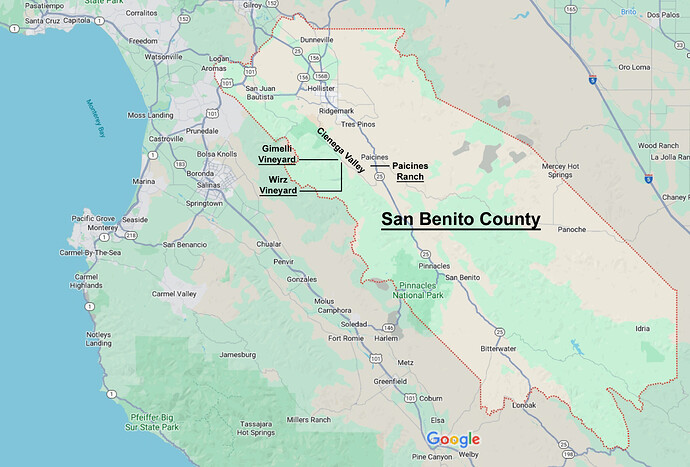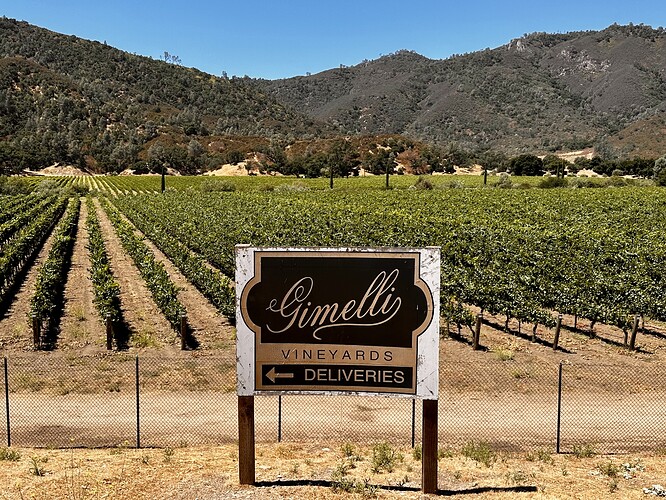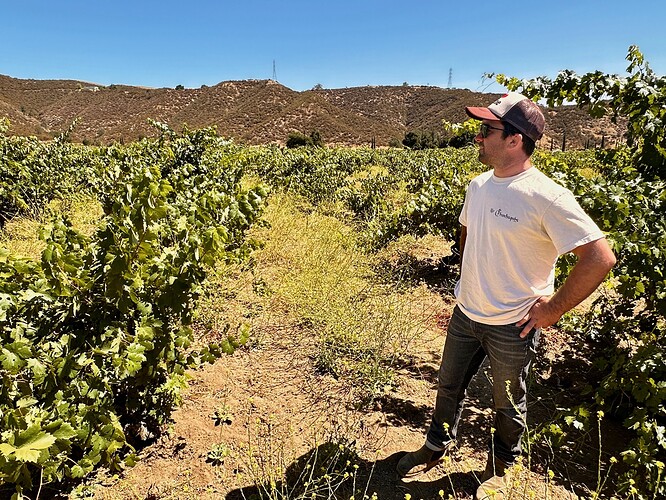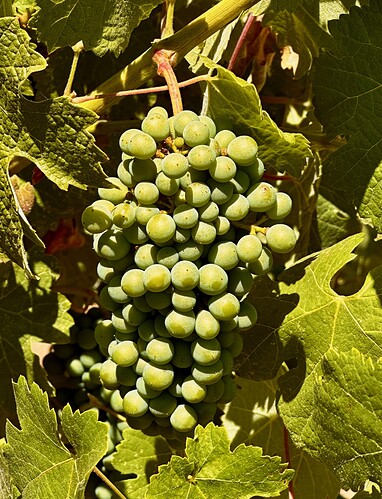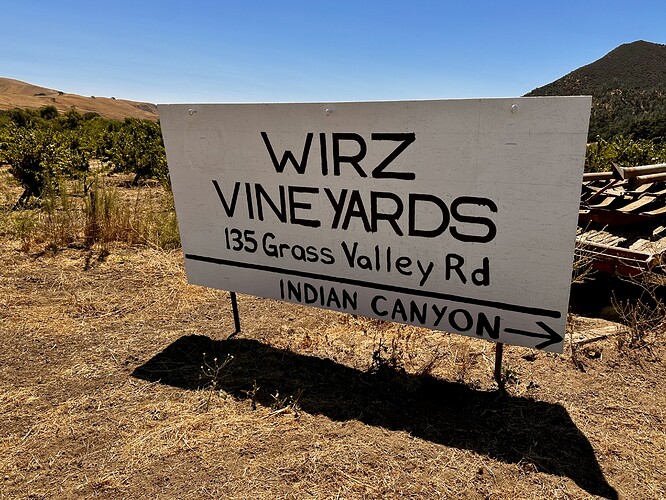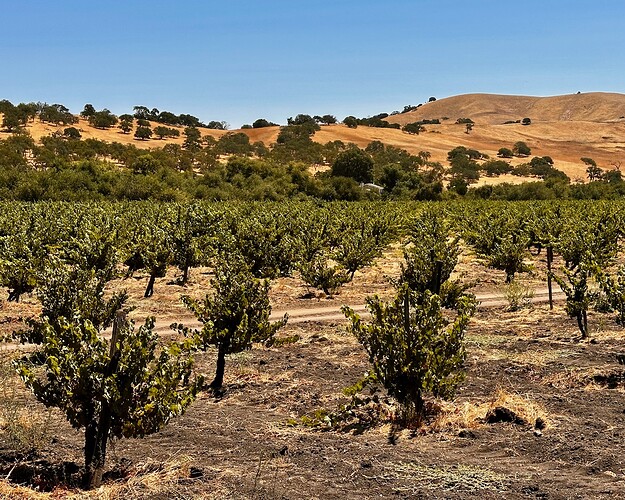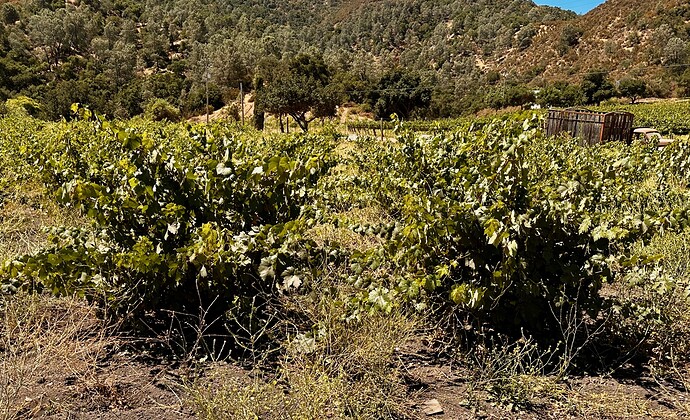San Benito County Vineyards and Wine – Part 1, Gimelli Vineyard and Wirz Vineyard
I’ve posted a portion of a report on July wine visits with friends Wes and Larry to Gimelli and Wirz vineyards and to Paicines Ranch, all in California’s San Benito County, finishing with a visit to Stirm Wine Co. This portion covers the visits to Gimelli Vineyard and Wirz Vineyard, both located in Cienega Valley – a post covering Paicines Ranch and Stirm will be following soon. The full version of the report is on the Grape-Nutz.com website:
Gimelli Vineyard and Wirz Vineyard - July 2025
Before proceeding further, it might be useful to provide a brief introduction to San Benito County and its place in California wine history.
Introduction to San Benito County
The vineyards of San Benito County include some of the older plantings in California, yet they’re not very well-known, even among many fans of California wine. The region is located south of Santa Clara Valley and east of Monterey County, between the Gabilan and Diablo mountain ranges. It’s generally warm during the summer, though afternoon maritime breezes coming down from Monterey Bay and through the Hollister area help to temper the heat. Historically, agriculture and mining (mainly for quicksilver) have been important to the county’s economy. Though mining operations have fallen off, farming and ranching remain strong – apricots have been one of San Benito’s most notable crops over the years. The region includes two major earthquake faults – the San Andreas and Calaveras faults run through the county, contributing to its interesting geology and mix of rock and soil types, including volcanics, decomposed granite, and limestone, as well as some rare minerals. Rock quarries for granite and limestone continue to operate in the Cienega Valley area.
The first commercial winegrape plantings in San Benito County came around 1851, when Frenchman Théophile Vaché planted vines in Cienega Valley, at what are now DeRose and Eden Rift vineyards. It’s been said that some of Vaché’s vines planted in the mid-1850s remain at DeRose. William Palmtag purchased Vaché’s vineyard in 1883 and expanded it, adding more grape varieties. Enz Vineyard, in the same area, may have first been planted as early as the 1880s, and some of those vines are still producing. Other vineyards that were initially planted by the early 1900s include Wirz and Gimelli (formerly El Gabilan). Wirz also has Riesling vines dating to the early 1960s. Josh Jensen began planting his Calera vineyards in the Mount Harlan area in 1974. San Benito County’s vineyard heyday came in the 1970s when wine giant Almaden had over 3,000 acres of vineyards in the area. But that era didn’t last long for the region, and most of those vineyards are gone now. Newer plantings of note in the past 30-40 years include Siletto Family, Vista Verde, Pinnacle, and Paicines Ranch vineyards.
San Benito County includes five AVAs entirely within the county borders: Cienega Valley (1982), Lime Kiln Valley 1982), Paicines (1982), San Benito (1987), and Mount Harlan (1990). There are also three AVAs that are partially within San Benito County, including their most recent one, Gabilan Mountains (2022).
In the past ten years or so, a number of smaller-scale vintners have discovered the vineyards of San Benito County and have sought out fruit from there, particularly older plantings of varieties such as Négrette and Cabernet Pfeffer, which may not be grown anywhere else in California. And the newer vineyards in particular have planted or grafted many varieties originally from Italy, Spain, Greece, France, and elsewhere in Europe that are little-known in California vineyards. Nearly all of these vintners make their wines outside of San Benito County, and there are still very few wineries within the county itself.
Gimelli Vineyard
Ryan drove Wes, Larry, and I southeast from his winery in Aromas, going through the small town of San Juan Bautista and eventually turning onto Cienega Road. As we proceeded south through Cienega Valley, we passed DeRose Winery and Eden Rift Vineyards, where we’d visited a few months earlier, and then soon also passed the road leading up to Calera Wine Company, located higher in the hills of the Mt. Harlan AVA. When we started along Cienega Road, Ryan mentioned how poor the pavement is along much of the road, something that Wes, Larry, and I had certainly noticed on our earlier visit to the area. Ryan said that due to the road condition, it was not his favorite route for hauling a load of grapes back to his winery, and it wasn’t hard to understand why!
Cienega Valley straddles the San Andreas Fault, and the site includes different soil types on either side. The eastern side has clay and sandstone soil, with the higher portions to the west of the fault have more granitic and calcareous soil. Ryan mentioned that the soil on the west side of the fault – where most of the older vines in the area are located – is quite sandy, and this is partly why the old own-rooted vines there have been resistant to phylloxera over the years. The Cienega Valley climate is quite warm during the growing season but winds from Monterey Bay typically cool it off starting in the mid-afternoon so there’s a considerable diurnal temperature swing in the vineyards. The fruit typically retains good acidity due to the cool nighttime temperatures and the wind. Ryan said that there’s adequate groundwater around the valley floor but much less available as you get up onto the surrounding hillsides.
Not far past the road to Calera, Ryan turned west from Cienega Road and into Gimelli Vineyard, in the heart of the Cienega Valley growing region. Originally known as El Gabilan Vineyard, this was the source of vine cuttings that went to a number of other San Benito County vineyards. Probably most of the Cabernet Pfeffer vines that are now grown in San Benito County originated from this vineyard.
The beginnings of Gimelli Vineyard aren’t entirely clear, but it’s likely that about 15 acres of grapevines were planted in the 1890s though those earliest vines at the site may now be gone – it’s unknown who planted them and what variety or varieties were there. In 1907, University of California Viticulture and Enology Professor Frederic Bioletti and physician Dr. Harold Ohrwall purchased the vineyard and began managing it the following year. They planted around 75 additional acres in 1908 and the total vineyard size was up to 100 acres by 1912. Professor Bioletti had gone back to teaching at UC by then, but Dr. Ohrwall built a winery and continued farming the vineyard and making wine there. His El Gavilan Winery survived Prohibition by selling grapes to East Coast home winemakers, and Dr. Ohrwall operated the winery until selling his property to Taylor & Co. in 1944. The property was taken over by Almaden in 1963, and after Heublein acquired that company in 1987 they soon began to liquidate Almaden’s large property holdings. Ken Gimelli purchased the old El Gabilan Vineyard property in 1995 and renamed it Gimelli Vineyard.
Gimelli Vineyard is now about 130 acres in size, on a property of around 350 acres. Ryan told us that the vineyard size was once larger. The site is at an elevation of 900 to 1,000 feet, and has mostly sandy limestone and granite soil. Most of the organically-farmed vineyard contains plantings that Ken Gimelli put in starting around 1997, and it includes Chardonnay, Pinot Noir, Sangiovese, Chenin Blanc, Gamay Noir, Viognier, and Merlot. Only 12.5 acres of the old vines remain, with 7.5 acres of Zinfandel and 5 acres of Cabernet Pfeffer. It’s not known for certain whether these vines pre-date Bioletti and Ohrwall’s involvement in the vineyard but it seems probable that they planted them in 1908.
Ryan and old-vine Zinfandel vines
Since Ryan knew that our main interest in visiting Gimelli Vineyard was to see the old vines there, he drove us along the dirt vineyard roads past most of the newer plantings until we came to a block of old head-trained vines – this was the Zinfandel block. We got out of the truck and walked over to take a closer look at the vines. As was the practice when these vines were planted, they’re all own-rooted and dry-farmed. The vines are surprisingly small considering that they’re now well over 100 years old – only a lone Cabernet Sauvignon vine amongst the Zin had the big gnarly trunk you think of when you picture old vines. Ryan was interested in seeing how the fruit clusters were developing, and there was still no sign of veraison on any of the vines we looked at.
We got back into Ryan’s truck and he continued for a short distance farther up the dirt road to the old-vine Cabernet Pfeffer block, probably planted at the same time as the Zinfandel. Like the Zin, these vines are own-rooted, head-trained, and dry-farmed. We quickly noticed that the Cabernet Pfeffer vines are taller and more stout than the Zinfandel vines, with a larger sprawling canopy of leaves. Ryan told us that the large canopy is particularly needed for the Cab Pfeffer, as this variety can more easily get bleached or burned by too much direct sun on the grape clusters. He also noted that the Cab Pfeffer ripens later than the Zinfandel, and he usually brings it in from late September to late October depending on the vintage. As with the nearby Zin vines, we could find no veraison yet in any of the Cab Pfeffer grape clusters that we saw.
Cabernet Pfeffer cluster
In addition to the old-vine Zinfandel and Cabernet Pfeffer, Ryan gets Chardonnay, Sangiovese, and Chenin Blanc from Gimelli Vineyard. A number of other noted vintners source fruit from the site, mostly but not all from the Santa Cruz Mountains and northern Central Coast regions.
Wirz Vineyard
After Wes, Larry, and I hopped back into the truck with Ryan, we didn’t have far to go to our next stop of the day. It was just past a fence line to Wirz Vineyard, which is directly adjacent to Gimelli Vineyard to the south. As with Gimelli, it’s just about 1,000 feet in elevation with the same type of sandy granite- and limestone-based soil and the same significant diurnal temperature swing during the growing season. There are a number of different types of limestone, and Ryan said that much of what’s in Cienega Valley limestone is calcite – one of the Stirm wines that Ryan makes is a white blend called “Calcite.” He also noted that while dry-farming grapevines is possible in Cienega Valley, that’s difficult to do just over the hills to the east near Highway 25 (the main highway through San Benito County), where it’s hotter and there is less rainfall, so vineyards in that area are typically irrigated.
Owned by Pat Wirz and his family, Wirz Vineyard is another old one, with 6-7 acres first planted by the Pivetti family around 1902 or 1903. As with many old plantings, there is a mix of varieties interplanted, including Zinfandel, Cabernet Pfeffer, Mataro (aka Mourvèdre), Carignan, Rosa del Peru (aka Mission), and probably a little Palomino and Orange Muscat. An additional planting of similar mixed varieties was added in the 1920s – as with the earlier planting, the vines are head-trained, own-rooted, and dry-farmed. The Pivetti family owned the property until Pat’s father purchased it in 1947. Although he didn’t buy the land for the small vineyard there – it was mainly intended for cattle ranching – Pat’s father continued to farm the grapevines and sell the fruit. Pat has said that he started working with his father in the vineyard when he was not even five years old. Pat’s father acquired additional property in Cienega Valley after that initial 1947 purchase, mainly for ranching.
Pat worked at Almaden for nearly 15 years, and left there after the company was sold to Heublein in 1987. Since then he’s worked for seed companies in addition to his own farming and ranching. Pat’s father passed away in 1992, and he’s been managing the vineyard since then. Pat’s son Donald is the winemaker for Delicato, while his grandson Cody is now working with Pat at the Wirz family properties. In addition to the 60 acres of organically-farmed grapevines at Wirz Vineyard, the family currently owns or leases about 1,500 acres of land in the region and still raises cattle and grows grain for feeding them. Pat has been an outspoken advocate for ranching and farming in the county, and is a past president of the San Benito County Farm Bureau.
Besides the old blocks of mixed varieties, what makes Wirz Vineyard unique in this region are its Riesling vines that were planted in 1963-1964. This 40-acre Riesling block was planted by Almaden when they owned this particular property – they had the Wirz family farm it since they lived adjacent to it. The Wirz family purchased the parcel from Almaden in 1983 and they’ve continued to farm it ever since. Though there are other remnants of the once-enormous Almaden plantings in San Benito County, the Wirz Riesling block may be the oldest. Perhaps surprisingly for a 1960s-era planting, these Riesling vines are own-rooted, and they’re head-trained and dry-farmed just like the older vines at Wirz. Ryan told us that there’s a small percentage of other varieties in the Riesling block – Chardonnay, Sauvignon Blanc, and probably a little Chenin Blanc and Sauvignon Vert as well. Pat has noted that there wasn’t much of a market for Riesling for a number of years after his father bought the property and the fruit was typically sold to large corporate wineries – though some years they couldn’t find a buyer at all. They were eventually able to find a steady buyer in Randall Grahm, who used the Wirz fruit as a significant component of his Pacific Rim Riesling for a number of years.
Old-vine Riesling
Ryan stopped his truck next to the Riesling block and we all got out to look at the vines. The Riesling grape clusters were noticeably smaller than the Zin and Cab Pfeffer clusters we’d seen at Gimelli Vineyard. Ryan also showed us the mixed block of 1920s vines – unlike the Riesling, that small vineyard block had a lot of vegetation all around the vines so we were hesitant to venture in. And though we didn’t get a close-up look, Ryan pointed out past the 1920s block where the older 1903 plantings are located, at the base of a hillside. One block there is mostly Mataro and Zinfandel while the rest is primarily Zinfandel plus Mataro, Cabernet Pfeffer, and other interplanted varieties. An interesting story that Pat has related is that the first commercial wine that Josh Jensen – of Calera Pinot Noir fame – made was Zinfandel from Wirz Vineyard.
Old mixed block of Zin, Cab Pfeffer, Mataro, etc.
Though I’m sure it would have been great fun to have met and talked with Pat Wirz – from everything I’ve heard about him, he’s quite a character – we still really enjoyed our visit to his vineyard. Wirz Vineyard has become one of San Benito County’s best-known vineyard sites over the past ten years or so, as more vintners have produced vineyard-designated wines from there. Farming practices are organic, though the vineyard is not certified. Ryan started working with fruit from Wirz Vineyard in 2015, just about as soon as he made the move to Santa Cruz County from Santa Barbara County, where he’d previously been working. He gets Riesling, Zinfandel, Cabernet Pfeffer, and Rosa del Peru from Wirz, and a number of other highly-regarded producers work with Wirz Vineyard fruit as well.
